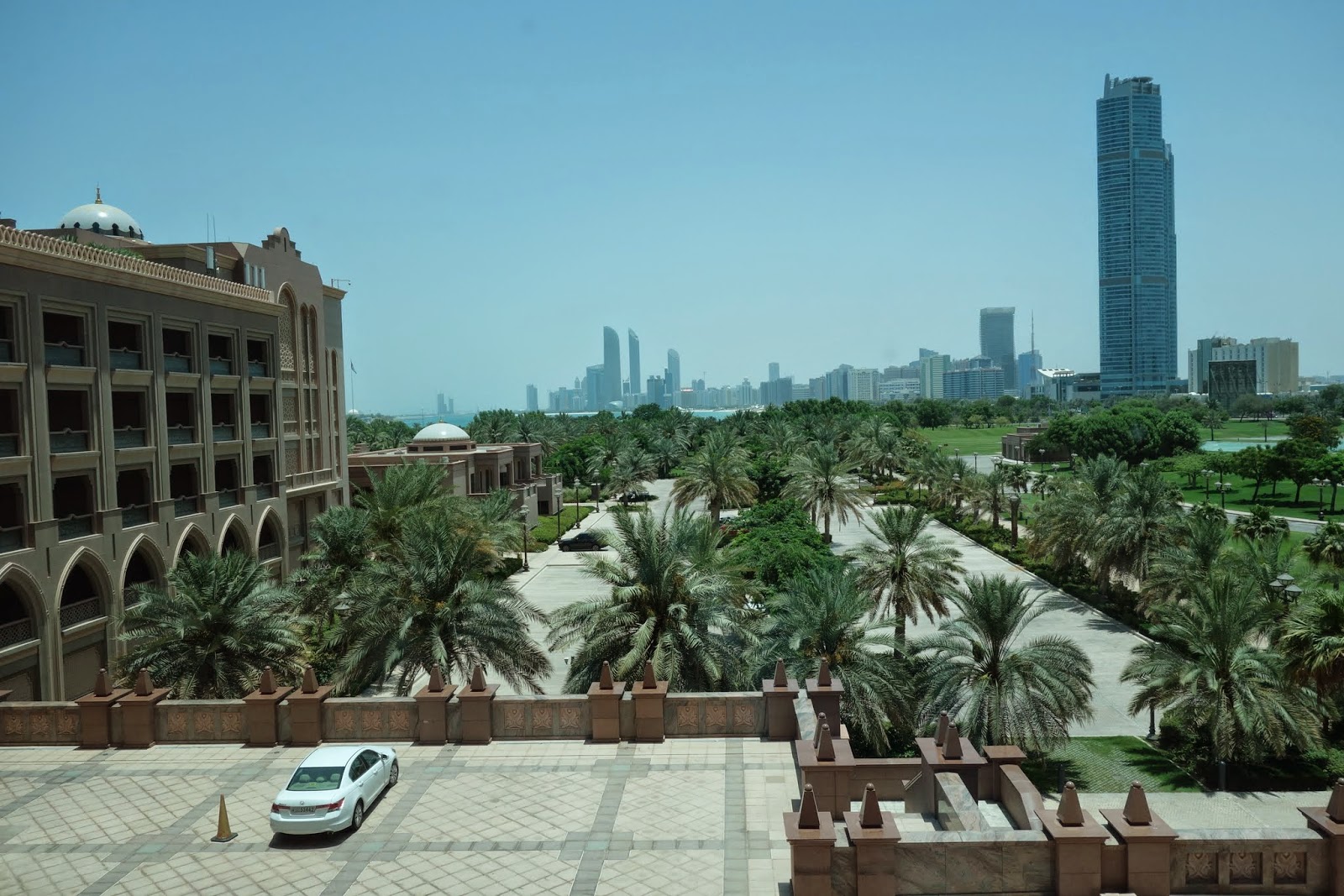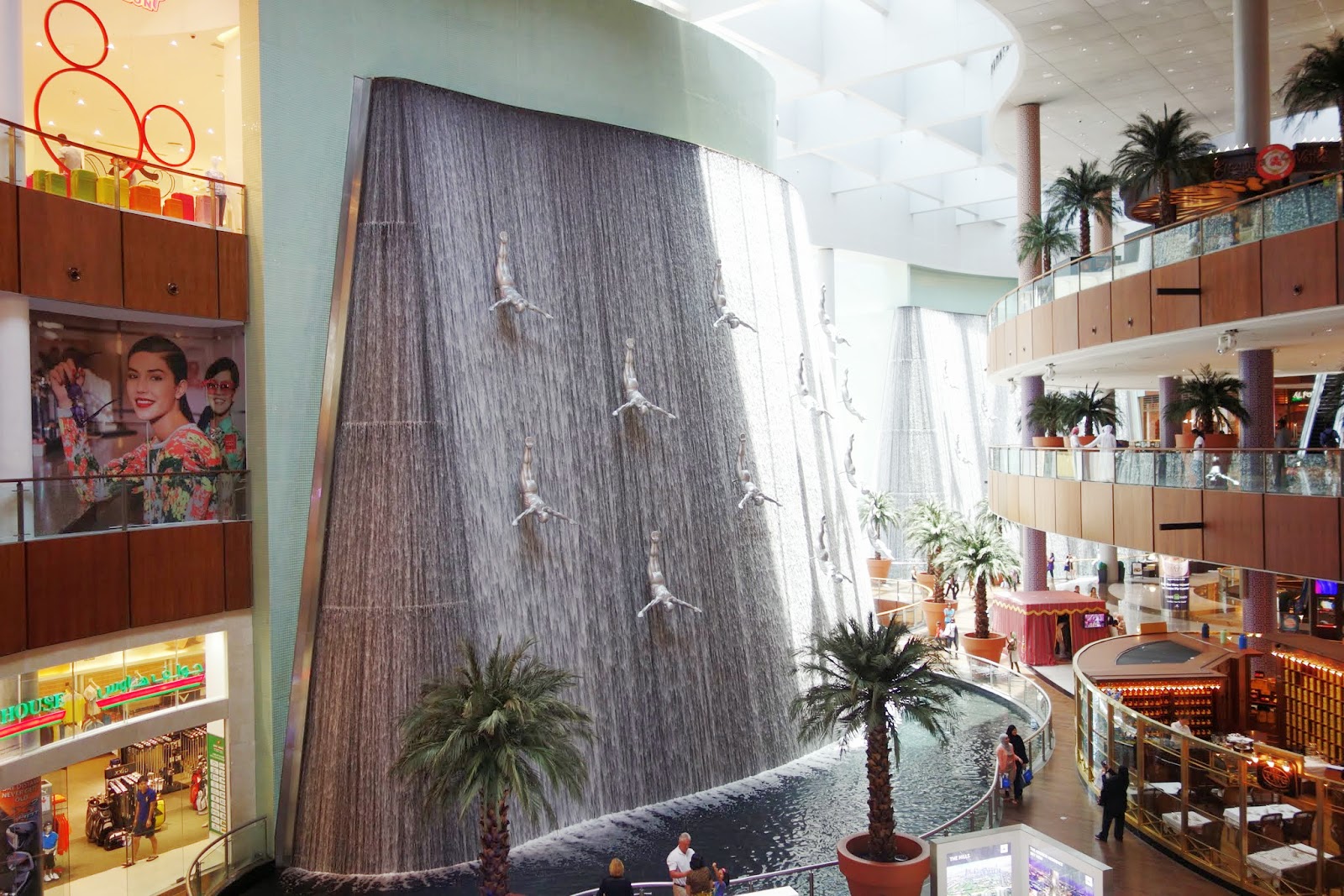20 - 25 May, 2014
So much construction! We were in Munich the year before the 1972 Olympics and we counted 50 cranes on the horizon. In Abu Dhabi we counted 50 cranes on the site of the airport terminal extension alone. Everywhere there is construction, not of single houses, flats, commercial buildings but of multiple buildings wherever you looked, almost. That is probably the most overwhelming difference between home and the places we visited in the UAE. Development is the name of the game.
Most impressive, perhaps was what has been done with water and greenery, to turn the vast, flat plains of desert into a 'green and pleasant land', to quote Blake of England. Where there is no watering system, you will find sand, more sand, and the occasional scrappy growth.
Better known for shopping than sand, Abu Dhabi and Dubai both sport numbers of enormous malls. Not only is every famous brand available for the discerning shopper, (and imitations for the less discerning) but you will also find the French supermarket chain Carrefour, numerous English and European shops (Marks and Spencer, H and M, Zara, Sephora for example) and vast entertainment areas including fun fairs, ice rinks, and in Dubai, the world's largest indoor ski slope.
On the road out of Al Ain, is a huge mall (400 shops), with ice rink, fun fair and a set of slides lined with snow which you can, for a price, slide a toboggan down. Not at all unusual.
And all this massive development has taken place in our lifetime, since the 1960s.
Our time with Melanie, Jim and Madeleine passed very quickly. We rested on day one, although Scarlett the dog did get a slight excursion between our naps. Over the next few days we explored places we hadn't seen before, starting with the old fort, Qasr al Hosn, which is undergoing serious 'rehabilitation' but has an interesting display on the history and accomplishments of the ruling family, the Al Nahyan family.
 The Heritage Village shows us a little of what has now been 'developed' out of existence - a reconstruction of a typical oasis village, with local crafts such as metalwork and pottery, small shops selling craftwork, the old desert dwellings, both winter and summer. In the 42° heat we could appreciate the shade offered by the traditional dwelling but it was still pretty hot in there! We also took in an exhibition or two, and passed through areas currently being developed (there will be a Louvre and Guggenheim there in a few years' time). And we rested.
The Heritage Village shows us a little of what has now been 'developed' out of existence - a reconstruction of a typical oasis village, with local crafts such as metalwork and pottery, small shops selling craftwork, the old desert dwellings, both winter and summer. In the 42° heat we could appreciate the shade offered by the traditional dwelling but it was still pretty hot in there! We also took in an exhibition or two, and passed through areas currently being developed (there will be a Louvre and Guggenheim there in a few years' time). And we rested.
One day we visited a couple of very different hotels -the seven star Emirates Palace Hotel, ultra luxurious, incredibly expensive, built as an 'icon to Arabian culture and hospitality' about 10 years ago in a style designed to give visitors the experience of staying in a palace -totally over-the-top, totally amazing. It is normal for ordinary people like us to walk around the lobby and wings to east and west, as if in a museum or a chateau and all the staff are welcoming.
A short taxi ride took us to the ultra-modern (2011) Jumeirah at Etihad Towers hotel, with a view across the water to the city and an interesting water feature which had similarities with Rotorua's mud pools. This hotel is much less accessible than the Palace, though we were told that Ray's Bar, would have given us great views but did not open until late afternoon. (Note for next time.) There is also a lift up to a higher floor, for a price, but the mixture of dust was pretty thick and it didn't seem worth the expense for a hazy view.
In total contrast to all this ostentatious luxury, and on the other side of town, are the blocks of accommodation for immigrant workers. A male world, tens of thousands of immigrant workers housed often 10 or more to room, taken by bus to their worksites daily. There are many stories of bad conditions and grossly inadequate pay - but this is not what we are able to observe - just the acres and acres of residential blocks and the squalor surrounding them. An article in the paper said that 80% of money earned is sent back to their families but other articles say they have to work long hours with few rest days just to pay off their recruitment agents fees. Such enormous, if visionary, development has its cost in human terms.
The trip to Dubai is not too long. The road is flat and with few curves, one way all the way, multi-laned and at a certain point follows the new, driverless, fully-automated elevated metro which goes underground in the city. Reminded us of the line which took us to Odaiba from Central Tokyo (when Julian and Susan lived there).
We went along for the ride when Melanie went to pick up her sister and husband from the Dubai airport. Just enough time to swing by a huge mall for a coffee, check out the sky-scraper opposite, the tallest in the world, spend a few minutes at the aquarium in the mall watching a diver descend and wonder at some people in a cage - plenty of fish to watch as well - snap a few photos of the ice rink and the waterfall, and then continue on to the mega-large and ultra-modern airport, the largest and second-busiest in the world.
The waterfall covers the whole height of the mall
The airport
Moving back to moderation in size, we spent our last day in Al Ain, where Jim and Melanie had lived during their first stint in the UAE. It's somewhat over an hour from Abu Dhabi and the road takes you through farming areas, not just desert. There are also wonderful dunes, sometimes rising up behind date palms. Very pretty.
Al Ain was one of the original oases where people could be non-nomadic, as there was water available all the time and people could grow enough for their needs. It still has a huge date plantation which is open for visitors and displays the watering system that has worked for centuries.
 Our first stop in Al Ain was for a restorative coffee in the light and airy lobby cafe of the fairly enormous and sumptuous Rotana hotel. Totally recommended -although Al Ain is less humid than Abu Dhabi and maybe slightly cooler, it was still about 42°.
Our first stop in Al Ain was for a restorative coffee in the light and airy lobby cafe of the fairly enormous and sumptuous Rotana hotel. Totally recommended -although Al Ain is less humid than Abu Dhabi and maybe slightly cooler, it was still about 42°. 
Onwards then, to the local landmark, Abu Dhabi's highest mountain at 1240 m, Jabal Hafeet, bordering Oman. The spectacular road, called by some 'the sheik's driveway', as it leads to the former president's palace at the top, is carved through limestone and paved with top quality asphalt. It reminds you of the European roads that are closed off and used for racing circuits and is apparently similarly used by some of the locals.
 Virtually no native vegetation is found on the road up and at the top there is a more craggy limestone, a small snack bar and large parking lot with wide views over the countryside.
Virtually no native vegetation is found on the road up and at the top there is a more craggy limestone, a small snack bar and large parking lot with wide views over the countryside.
Near the top is a hotel from where there there are different magnificent views and they have a created their own little oasis in the middle of arid nothingness, with palm trees, grass, trees and a swimming pool.
The sheik's palace is on the edge of a ridge a little further up and has not quite so much lushness but enough to be comfortable. On the top of an arid mountain in the middle of nowhere. The views were hazy, due to dust, but it is nonetheless a spectacular place to go. This was our second visit and no less interesting for that.
Back on the flat again we visited the camel markets. Not just camels - sheep, goats, cattle - apparently they just stay there until they are sold. Plenty of shade and all in the fresh air. On to the oasis - not for long in the heat - just long enough to take in the watering canals really. We'd been here before too but at the beginning not the end of May. It makes a difference! There is a National museum close by, with lots of interesting material on the Bedouin way of life, among other displays.
Bedouin cradle, very much like the one we made for our second son Chris:
So lovely to have spent time with our friends and interesting to spend more time in this part of the world, so different fom our own. Thanks to all for making us so welcome.
 |
| Iranian Fast food in Mall |
 |
| Burj Dubai |




























































